Occurrence Characteristics of Magnetite and Aeromagnetic Prospecting Northeast of Hebei Province
Abstract
1. Introduction
2. Geological Background
2.1. Stratum
2.2. Structure
2.3. Intrusive Rock
3. Occurrence Characteristics of Magnetite in the Study Region
3.1. Sedimentary Metamorphic Magnetite
3.2. Magmatic Magnetite
4. Data
4.1. Data from Aeromagnetic Survey
4.2. Data from Ground Survey
4.3. Potential Field Conversion
4.4. Forward and Optimization
5. Aeromagnetic Response of Magnetite and Nonmagnetite
5.1. Magnetic Characteristics
5.2. Aeromagnetic Anomaly Characteristics of Typical Magnetite
5.2.1. Aeromagnetic Anomalies Related to Magnetite-Type Sedimentary Metamorphic Rocks
5.2.2. Aeromagnetic Anomalies Related to Magnetite-Type Magmatic Rocks
6. Magnetite Prospecting Prediction of Aeromagnetic
6.1. Prospect Attributes
6.1.1. Sedimentary Metamorphic Magnetite
- (1)
- Geological attributes
- Most of the ore occurrences are regions in basement uplift with exposure of magnetic basement (Neoarchean and Paleoproterozoic) or covering of thin Cenozoic. However, the negative structure is more conducive to preserving ore bodies. In particular, the regions of syncline axes and turning ends often have large-scale and thick ore bodies.
- The Dantazi group of the Neoarchaean is the main ore-bearing strata. The surrounding rocks of the deposit are various plagioclase gneiss, granulite, and granulite. The ore beds are mostly magnetite quartzite or magnetite amphibolite. The shapes are layered, stratoid, or lenticular. This occurrence is basically consistent with the surrounding rocks.
- The prospecting region is mainly located in the southern part of the study region, including southern Fengning County, southern Longhua County, and northern Luanping County in the Chengde area. Ore bodies mostly occur with the types in groups and zones. The strike direction of ore bodies mainly includes the near-EW directions. They are closely related to near-EW trending faults.
- (2)
- Aeromagnetic attributes
- Sedimentary metamorphic magnetite is mainly located in magnetic anomaly areas alternating between positive and negative.
- The shape of the magnetic anomaly is regular in the plane, mostly in the strip, oval and gourd directions. The long axis direction of the abnormality is mostly consistent with the strike of the metamorphic strata of the ore body. Most of the shapes of abnormal sections peaked. The side with a gentle gradient is consistent with the formation tendency.
- The combination of ore-induced magnetic anomalies is mostly distributed alternately in the form of intermittent banded or beaded positive magnetic anomalies. They are mainly in the near-EW direction. Very few show a near-NE direction.
- The amplitude of the magnetic anomaly changes greatly. High amplitudes of local magnetic anomalies often reflect exposed ore bodies or bodies that are near the surface.
- Using the method of upward continuation, the amplitude of the anomaly caused by magnetite decreases sharply with increasing upward continuation height.
6.1.2. Magmatic Magnetite
- (1)
- Geological attributes
- The prospecting region is mainly located in large fault zones of grade I, grade II, and their surroundings in the study area.
- The ore body is mainly composed of vanadium, titanium, and ilmenite. It contains a small amount of chromite, pyrite, chalcopyrite, apatite, etc. The metallogenic rocks are mainly basic rocks of gabbro, norite, and anorthosite. The secondary rocks are ultrabasic rocks of hornblende and pyroxenite.
- The ore body is an iron deposit of late penetrating magma. Iron ore deposits occur in groups under the control of structural fracture zones, contact zones of different lithofacies (gabbro and anorthosite contact zones), and primary structures.
- (2)
- Aeromagnetic attributes
- The linear gradient belt of magnetic anomalies with a large scale reflects the deep and large fault zone. Local magnetic anomalies with high amplitudes reflect the ultrabasic and basic rocks containing magnetite.
- The magnetic anomaly has an obvious superposition phenomenon. A positive magnetic anomaly of a large background region is caused by an ultrabasic and basic rock mass. The local closed anomaly with high amplitude superimposed on the background is a mine-induced anomaly.
- The shapes of magnetic anomalies reflecting the rocks and ore body are mostly elliptical and massive.
- Ore-induced magnetic anomalies with high amplitudes reflect closely arranged and centrally distributed ore bodies.
- If the concealed depth of rocks and ore body is large, it is difficult to distinguish them by using only an isoline plan or profile of aeromagnetic anomaly ΔT. Upward continuation should be used. The ore anomaly decays rapidly if the height of upwards extension increases.
6.2. Magnetite Prediction Method
6.2.1. Ore Prediction Region of Iron Polymetallic in Laochenjia (I-1)
6.2.2. Iron Ore Prediction Region of Dabai-Henan (I-2)
6.2.3. Iron Ore Prediction Region of Jiuwuying-Baiyingzi (I-3)
6.2.4. Ore Prediction Region of Iron Polymetallic in Beierying (I-4)
6.2.5. Ore Prediction Region of Iron Polymetallic in Sidaogoumen (I-5)
6.2.6. Ore Prediction Region of Iron Polymetallic in Wuyingizi (I-6)
7. Discussion and Conclusions
7.1. Discussion
- (1)
- From the regional geological mineral figures (Figure 1) and aeromagnetic data ∆T map (Figure 6), the line of Shangyi-Fengning-Longhua is a demarcated magnetite metallogenic boundary northeast of Hebei province. The southern region of this line (refer to southern region) belongs to the deep metamorphic rocks of the Archean and iron-rich region in eastern Hebei. Deep metamorphic rocks of the Archean are widely exposed in this region. Many large-scale sedimentary metamorphic-rich iron ores are distributed. Magnetites with mining values have not been found in the region between the north of the line and the northern margin of the North China block (referred to northern region). The sedimentary metamorphic and magmatic magnetite occurrences in this region need to be further studied. The regional distribution of stratigraphic, sedimentary-pyroclastic rock series of the Jurassic–Cretaceous and acid intrusive rocks of the late Paleozoic are widely distributed in the northern region. Medium-shallow metamorphic rocks of Neoarchean are exposed locally. They have low magnetite content. It can be seen that the southern region has better metallogenic conditions for sedimentary metamorphic magnetites. We should pay more attention to the prospect in the deep and surrounding areas of the known mining areas. The northern region has better metallogenic conditions for gold, silver, lead, zinc, and molybdenum polymetallic deposits. We should pay further attention to this kind of mineral product.
- (2)
- From the characteristics of regional geology and mineral resources distribution, the fault zone in Shangyi-Fengning-Longhua plays an important role in controlling the metallogenic belt. Along the Shangyi-Fengning-Longhua fault zone, there are not only deep metamorphic rocks of the Archean and basic-ultrabasic intrusive rocks, but also sedimentary metamorphic and magmatic magnetites distributed in these belts. This important strata-structure-magmatic-magnetite belt reflects that the Shangyi-Fengning-Longhua fault is a deep fracture with large cutting depths and long extension distances, which should cut into the deep mantle. Therefore, the formation and evolution of this fault belt and its ore-controlling functions should be further studied.
- (3)
- It is very effective to identify correctly different characteristics of aeromagnetic anomalies for searching magnetites directly. Under normal conditions, the sedimentary rocks have no or weak magnetism. They often show negative magnetic anomalies or low-weak anomalies on the aeromagnetic map. The magnetic strengths of metamorphic rocks are different. The shapes of positive magnetic anomalies are mostly planes or blocks. Most intrusive rocks have certain magnetic properties. Their magnetic strengths are different because of the different lithologies. The shapes of positive magnetic anomalies are mostly perfectly round or belt. The volcanic rocks are mostly magnetic, but their magnetic strengths of them vary greatly. Most of them show positive magnetic anomalies with a marked jump. The magnetites have strong magnetic strengths and high anomaly amplitudes. It has significant differences from other magnetic anomalies. It is easy to be identified from the characteristics of magnetic anomalies. The kind of magnetites should be determined based on the geological background. For example, the sedimentary metamorphic magnetites are distributed in the geological background areas with deep metamorphic rock. The magmatic magnetites are distributed in the distribution regions with basic-ultrabasic intrusive rocks. In a few cases, there are similar aeromagnetic anomalies that belong to the reactions of different strata or lithologies. It can be determined in combination with the geological background.
7.2. Conclusions
- (1)
- The zone from Laochenjia to Wuyingzi has the metallogenic conditions of sedimentary, metamorphic, and magmatic iron deposits. More than 10 aeromagnetic anomalies with large scales and high amplitudes are developed in this region. It is one of the important aeromagnetic anomaly zones in northeastern Hebei. Combining the results of physical measurements and ground verification, aeromagnetic anomalies with high amplitudes are mainly caused by shallow magnetite deposits or ultrabasic rocks containing magnetite in this region. Therefore, the aeromagnetic anomalies with high amplitudes in Laochenjia, Daba-Henan, Jiuwuying, Baiyingzi, Beierying, Sidaogoumen, and Wuyingzi should be regarded as key prospecting targets.
- (2)
- Using methods of aeromagnetic reduction to pole, upward continuation, vertical derivative, conversion processing of residual anomaly data, and 2.5 D forward and inverse fitting, combined with geological outcrops, known iron deposits, ground magnetic surveys, and anomaly verification, we can carry out qualitative interpretation and quantitative calculation of magnetic bodies and then judge the distribution form and burial depth.
- (3)
- Based on the latest and measured aeromagnetic data with large areas and high precision, we can quickly screen aeromagnetic anomalies with prospecting significance. Based on high-precision aeromagnetic surveys, combined with geomagnetic methods, electrical methods, soil geochemistry, and other verification methods, it is an important way to realize accurate, rapid, and efficient ore prospecting.
Author Contributions
Funding
Conflicts of Interest
References
- Zhai, Y.S.; Yao, S.Z.; Cai, K.Q. Mineral Deposits; Geological Publishing House: Beijing, China, 2011; pp. 61–98. [Google Scholar]
- Cai, S.H.; He, H.Y.; Zhu, R.X. Magnetostratigraphic study of lower Cretaceous at Chengde Basin, Yanshan area and its restriction on North China Craton destruction. Chin. J. Geophys. 2012, 55, 66–75. [Google Scholar]
- Chen, C.L.; Jin, S.; Rong, G.L. Ore-controlling features of volcanic structure and prospecting potential in heshundian, Northern Hebei Province. Geophys. Geochem. Explor. 2011, 35, 461–467. [Google Scholar]
- Zhou, J.L.; Luo, Z.H.; Pan, Y.; Li, X.D. The genesis of vein-type iron orebody occurred in magmatic iron deposit: A case study of the Heishan iron deposit, Hebei Province, China. Acta Petrol. 2013, 29, 3555–3566. [Google Scholar]
- Hao, J.J.; Guo, H.Q.; Li, C.Z. The review and prospects of mineral exploration methods for the hanxing-type iron deposits in Hebei, China. Geol. Surv. Res. 2008, 31, 315–320. [Google Scholar]
- Sun, W.H.; Yang, J.L.; Li, H.J.; Liu, W.G.; Ma, S.J. Differences in properties between Pebbles and Raw ore from a SAG mill at a zinc, tin-bearing mine. Minerals 2022, 12, 774. [Google Scholar] [CrossRef]
- Zhang, Z.L.; Zhang, C.; Li, Y.; Wang, L.Y.; Gao, J.L.; Ma, M.; Li, Y.D. Petrogenesis and Geological Significance of the QuartzMonzonites in the Jinling Area, Western Shandong Province. Minerals 2022, 12, 771. [Google Scholar] [CrossRef]
- Jiang, S.H.; Liang, Q.L.; Bagas, L. Re–Os ages for molybdenum mineralization in the Fengning region of northern Hebei Province,China: New constraints on the timing of mineralization and geodynamic setting. J. Asian Earth Sci. 2014, 79, 873–883. [Google Scholar] [CrossRef]
- Li, H.M.; Li, L.X.; Zhang, Z.C. Alteration of the Damiao anorthosite complex in the northern North China Craton: Implications for high-grade iron mineralization. Ore Geol. Rev. 2014, 57, 574–588. [Google Scholar] [CrossRef]
- Li, L.X.; Li, H.M.; Che, Z.L. Hydrothermal mineralization and fluid inclusion study on the Heishan iron deposit, Chengde County, Hebei Province, China. Acta Petrol. 2010, 26, 858–870. [Google Scholar]
- Li, Z.H.; Zhu, X.K. Geochemical features of Xuanlong type iron ore deposit in Hebei Province and their geological significances. Acta Petrol. 2012, 28, 2903–2911. [Google Scholar]
- Liu, Y.X.; Li, W.Y.; Cao, A.Q. Recognition of Tuquan basin structure based airborne gravity magnetic characteristics. Geol. Surv. China 2018, 5, 44–50. [Google Scholar]
- Lu, Q.Q.; Luo, S.S.; Li, L.J. Sedimentary facies and geochemical characteristics of Mesoproterozoic GaoyuzhuangFomation in Xuanlong Depression. Fault–Block Oil Gas Field. 2011, 18, 312–316. [Google Scholar]
- Chen, Z.L.; Chen, B.L.; Li, H.M.; Du, W.H.; Li, L.X.; Han, F.B.; Wang, Y.; Sun, Y.; Wu, Y.; Zhang, W.G. Geological Characteristics of the Damiao Iron Deposit, North China Craton and Ore-Prospecting. Acta Petrol. 2014, 88, 2339–2350. [Google Scholar]
- Bai, X.; Liu, S.W.; Wang, W. U-Pb geochronology and Lu-Hf isotopes of zircons from newly identified Permian-Early Triassic plutons in western Liaoning Province along the northern margin of the North China Craton: Constraints on petrogenesis and tectonic setting. Int. J. Earth Sci. 2013, 102, 671–685. [Google Scholar] [CrossRef]
- Liu, Y.X.; Li, W.Y.; Xu, J.C. The utilizaion of wavelet magnitude method of gravity anomaly in fault identification. Geophys. Geochem. Explor. 2014, 38, 96–99. [Google Scholar]
- Campbell, R.E. Multilevel aeromagnetic response curves over selected iron deposits and igneous rock types. Lead. Edge 2009, 28, 1198–1202. [Google Scholar] [CrossRef]
- Centeno, R.; Schou, J.; Hayashi, K. The helioseismic and magnetic imager (HMI) vector magnetic field pipeline: Optimization of the Spectral Line Inversion Code. Sol. Phys. 2014, 289, 3531–3547. [Google Scholar] [CrossRef][Green Version]
- Duan, C.; Li, Y.H.; Wei, M.H. U-Pb dating study of detrital zircons from the Chuanlinggou Formation in Jiangjiazhai iron deposit, North China Craton and its geological significances. Acta Petrol. 2014, 30, 35–48. [Google Scholar]
- Osinowo, O.O.; Akanji, A.O.; Olayinka, A.I. Application of high resolution aeromagnetic data for basement topography mapping of Siluko and environs, southwestern Nigeria. J. Afr. Earth Sci. 2014, 99, 637–651. [Google Scholar] [CrossRef]
- Anderson, E.D.; Hitzman, M.W.; Monecke, T. Geological analysis ofaeromagneticdata from southwestern Alaska: Implications for exploration in the area of the pebble porphyry Cu-Au-Mo deposit. Econ. Geol. 2013, 108, 421–436. [Google Scholar] [CrossRef]
- Bansal, A.R.; Anand, S.P.; Rajaram, M. Depth to the bottom of magnetic sources (DBMS) from aeromagnetic data of central India using modified centroid method for fractal distribution of sources. Tectonophysics 2013, 603, 155–161. [Google Scholar] [CrossRef]
- Ding, W.J.; Chen, Z.L.; Chen, B.L. Geochemical characters of band iron formations in Xingshan iron deposit in Qian’an area, Hebei Province: Implication for their origin. J. Geomech. 2009, 15, 363–373. [Google Scholar]
- Mahdi, A.M.; Eldosouky, A.M.; Khateeb, S.O.E.; Youssef, A.M.; Saad, A.A. Integration of remote sensing and geophysical data for the extraction of hydrothermal alteration zones and lineaments; GabalShilman basement area, Southeastern Desert, Egypt. J. Afr. Earth Sci. 2022, 194, 104640. [Google Scholar] [CrossRef]
- Bencharef, M.H.; Eldosouky, A.M.; Zamzam, S.; Boubaya, D. Polymetallic mineralization prospectivity modelling using multi-geospatial data in logistic regression: The Diapiric Zone, Northeastern Algeria. Geocarto Int. 2022, 37, 1–36. [Google Scholar] [CrossRef]
- Ekwok, S.E.; Akpan, A.E.; Achadu, O.I.M.; Thompson, C.E.; Eldosouky, A.M.; Abdelrahman, K.; Andras, P. Towards Understanding the Source of Brine Mineralization in Southeast Nigeria: Evidence from High-Resolution Airborne Magnetic and Gravity Data. Minerals 2022, 12, 146. [Google Scholar] [CrossRef]
- Eldosouky, A.M.; El-Qassas, R.A.Y.; Pham, L.T.; Abdelrahman, K.; Alhumimidi, M.S.; El Bahrawy, A.; Mickus, K.; Sehsah, H. Mapping Main Structures and Related Mineralization of the Arabian Shield (Saudi Arabia) Using Sharp Edge Detector of Transformed Gravity Data. Minerals 2022, 12, 71. [Google Scholar] [CrossRef]
- Eldosouky, A.M.; El-Qassas, R.A.Y.; Pour, A.B.; Mohamed, H.; Sekandari, M. Integration of ASTER satellite imagery and 3D inversion of aeromagnetic data for deep mineral exploration. Adv. Space Res. 2021, 68, 3641–3662. [Google Scholar] [CrossRef]
- Eldosouky, A.M.; Pham, L.T.; Henaish, A. High precision structural mapping using edge filters of potential field and remote sensing data: A case study from Wadi Umm Ghalqa area, South Eastern Desert, Egypt. Egypt. J. Remote Sens. Space Sci. 2022, 25, 501–513. [Google Scholar] [CrossRef]
- Zhang, Y.D.; Song, J.S.; Gong, H.L. The relationship between distribution of iron deposits and characteristics of gravity and magnetic fields in Hebei Province. Geophys. Geochem. Explor. 2012, 36, 517–522. [Google Scholar]
- Yang, Y.H.; Liu, S.; Hu, R.Z. Geochemistry and petrogenesis of the SanchakouMaifc Dyke in Chengde, Hebei Province, China. J. Jilin Univ. 2012, 42, 1796–1805. [Google Scholar]
- Meng, G.X.; Yan, J.Y.; Lu, Q.T. Application of deep detecting technology in Hanxing subtype iron deposits and an integrated prospecting model:A case study ofBaijian iron deposit. Miner. Depos. 2009, 28, 493–502. [Google Scholar]
- Pan, L.H.; Li, L.Q.; Li, X. Sedimentary characteristics of the Jiufotang Formation developed in Luanping Mesozoic fault basin of northern Hebei Province. J. Geomech. 2010, 16, 85–95. [Google Scholar]
- Shen, J.F.; Zhang, H.F.; Li, S.R. Timing and genesis of the Beiminghe iron deposit, south of the Taihang Mountain (TM). In Proceedings of the 34th International Geological Congress, Brisbane, Australia, 5–10 August 2012; p. 423. [Google Scholar]
- Sun, J.; Du, W.H.; Wang, D.Z. Geological characteristics and genesis of the Heishan V-Ti magnetite deposit in Damiao, Chengde Hebei Province. Acta Geol. 2009, 83, 1344–1364. [Google Scholar]
- Sun, H.Y.; Ma, X.; Niu, Y.J.; Gao, Y.L.; Liu, W. Application of high precision magnetic survey for exploration of ironand delineation of target areas in Longwangmiao iron deposit inLonghua county, Hebei province. Geol. Surv. Res. 2017, 40, 71–75. [Google Scholar]
- Wang, Y.Q. Processing of magnetic anomaly data and application in the iron deposits in eastern Hebei Province. Geol. Resour. 2010, 19, 71–73. [Google Scholar]
- Lu, Y.; Li, J.; Bai, X.S. Application of magnetic survey on hidden iron deposit prospecting: A case study on Luanping-II iron deposit in Hebei China. J. Jilin Univ. 2008, 38, 698–702. [Google Scholar]
- Liu, D.B.; Shi, C.L.; Li, L.Y.; Zhao, Y.; Zhang, C.H. Geological characteristics and mining problems of Xuanlong iron ore deposit in Hebei province. China Min. Mag. 2016, 25, 94–97. [Google Scholar]
- Li, W.Y.; Liu, Y.X.; Lu, W.F.; Ma, G.Q.; Zhang, C.S.; Zhao, J.W. Characteristics of Zhangsanying-Tongshanzi aeromagnetic anomaly zone and prospecting potential of iron deposits in northern Hebei, China. Global Geol. 2020, 23, 99–115. [Google Scholar]
- Liu, Y.X.; Li, W.Y.; Yang, D.H.; Lu, W.F.; Wang, S.M. Study on characteristics of aeromagnetic anomaly and prospecting in Tuchengzi, Northwest Hebei Province. Prog. Geophys. 2019, 34, 2301–2308. [Google Scholar]
- Liu, Y.X.; Li, W.Y.; Ma, G.Q.; Cao, A.Q.; Gao, S.; Wang, N.; Lu, W.F.; Wang, L.J.; Yang, C. Oil and gas basin analysis based on airborne gravity and magnetic data. Appl. Geophys. 2022, 19, 1–17. [Google Scholar] [CrossRef]
- Zhang, Y.P.; Li, J.C. Tectonic framework and main characteristics of North China and its northward areas in Late Paleozoic-Early Mesozoic period. Geol. China 2010, 37, 916–930. [Google Scholar]
- Zhang, L.C.; Zhai, M.G.; Zhang, X.J. Formation age and tectonic setting of the Shirengou Neoarchean bandedirondeposit in easternHebei Province; constraints from geochemistry and SIMS zircon U/Pb dating Precambrian geology of China. Precambrian Res. 2012, 222–223, 325–338. [Google Scholar] [CrossRef]
- Zhang, S.H.; Zhao, Y.; Liu, J.M. Geochronology, geochemistry and tectonic setting of the Late Paleozoic-Early Mesozoic magmatism in the northern margin of the North China Block: A preliminary review. Acta Petrol. Mineral. 2010, 29, 824–842. [Google Scholar]
- Wang, B.D.; Wang, L.Q.; Chung, S.L.; Chen, J.L.; Yin, F.G.; Liu, H.; Li, X.B.; Chen, L.K. Evolution of the Bangong-Nujiang Tethyan ocean: Insights from the geochronology and geochemistry of mafic rocks within ophiolites. Lithos 2016, 245, 18–33. [Google Scholar] [CrossRef]
- Wang, B.D.; Wang, L.Q.; Chen, J.L.; Liu, H.; Yin, F.G.; Li, X. Petrogenesis of Late Devonian-Early Carboniferous volcanic rocks in northern Tibet: New constraints on the Paleozoic tectonic evolution of the Tethyan Ocean. Gondwana Res. 2017, 41, 142–156. [Google Scholar] [CrossRef]
- Zhai, M.G. Tectonic evolution and metallogenesis of North China Craton. Miner. Depos. 2010, 29, 24–36. [Google Scholar]
- Xiang, P.; Cui, M.L.; Wu, H.Y. Geological characteristics, ages of host rocks and its geological significance of the Zhoutaizi iron deposit in Luanping, Hebei Province. Acta Petrol. 2012, 28, 3655–3669. [Google Scholar]
- Zhao, Y.; Chen, B.; Zhang, S.H. Pre-Yanshanian geological events in the northern margin of the North China Craton and its adjacent areas. Geol. China 2010, 37, 900–915. [Google Scholar]
- Li, W.Y.; Liu, Y.X.; Xu, J.C. Onshore Offshore Structure and Hydrocarbon Potential of the South Yellow Sea. J. Asian Earth Sci. 2014, 90, 127–136. [Google Scholar] [CrossRef]
- Wang, B.D.; Chen, J.L.; Xu, J.F.; Wang, L.Q. Geochemical and Sr-Nd-Pb-Os isotopic compositions of Miocene ultrapotassic rocks in southern Tibet: Petrogenesis and implications for the regional tectonic history. Lithos 2014, 208–209, 237–250. [Google Scholar] [CrossRef]
- Wang, B.D.; Wang, L.Q.; Chen, J.L.; Yin, F.G.; Wang, D.B.; Zhang, W.P.; Chen, L.; Liu, H. Triassic three-stage collision in the Paleo-Tethys: Constraints from magmatism in the Jiangda–Deqen–Weixi continental margin arc, SW China. Gondwana Res. 2014, 26, 475–491. [Google Scholar] [CrossRef]
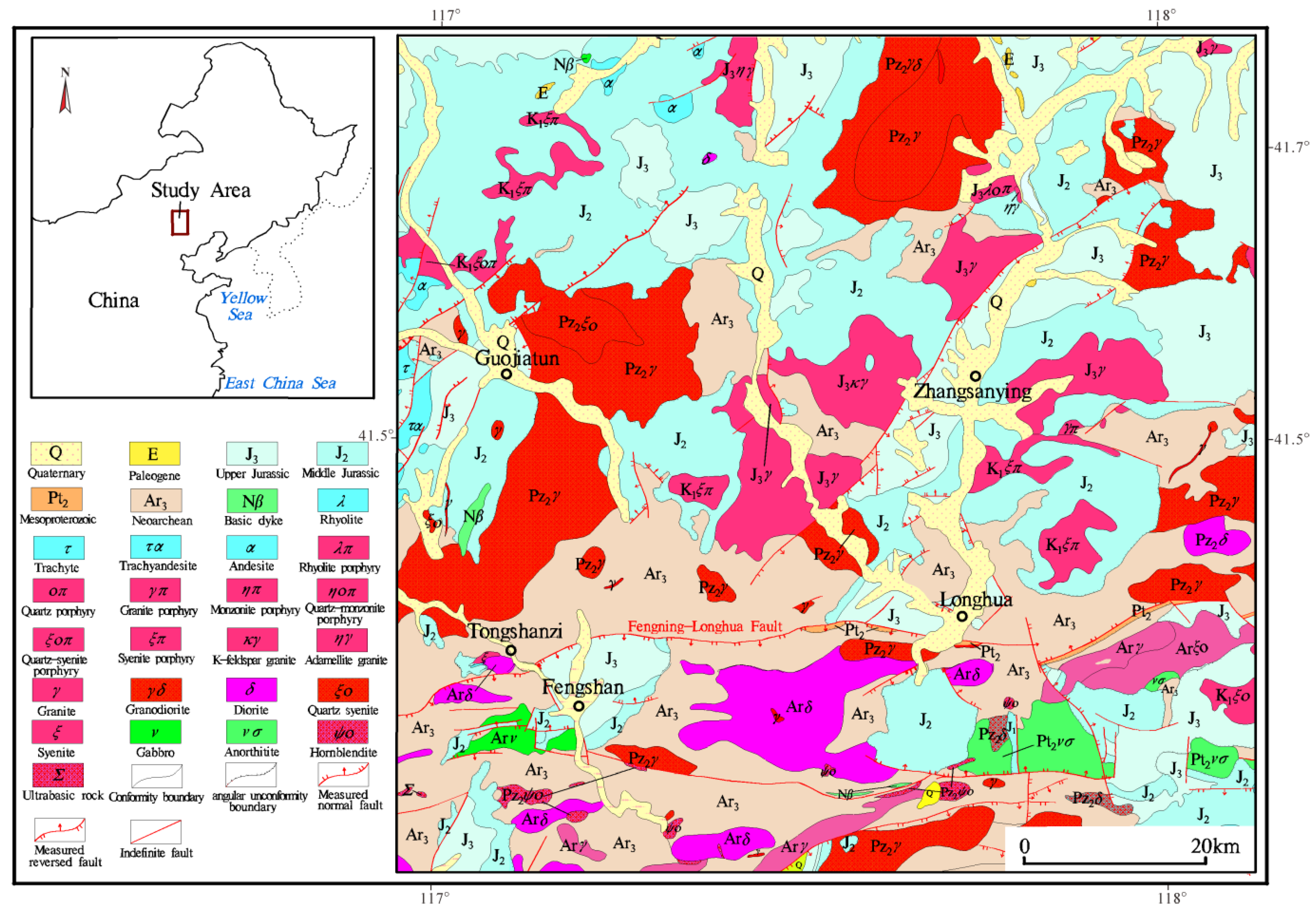
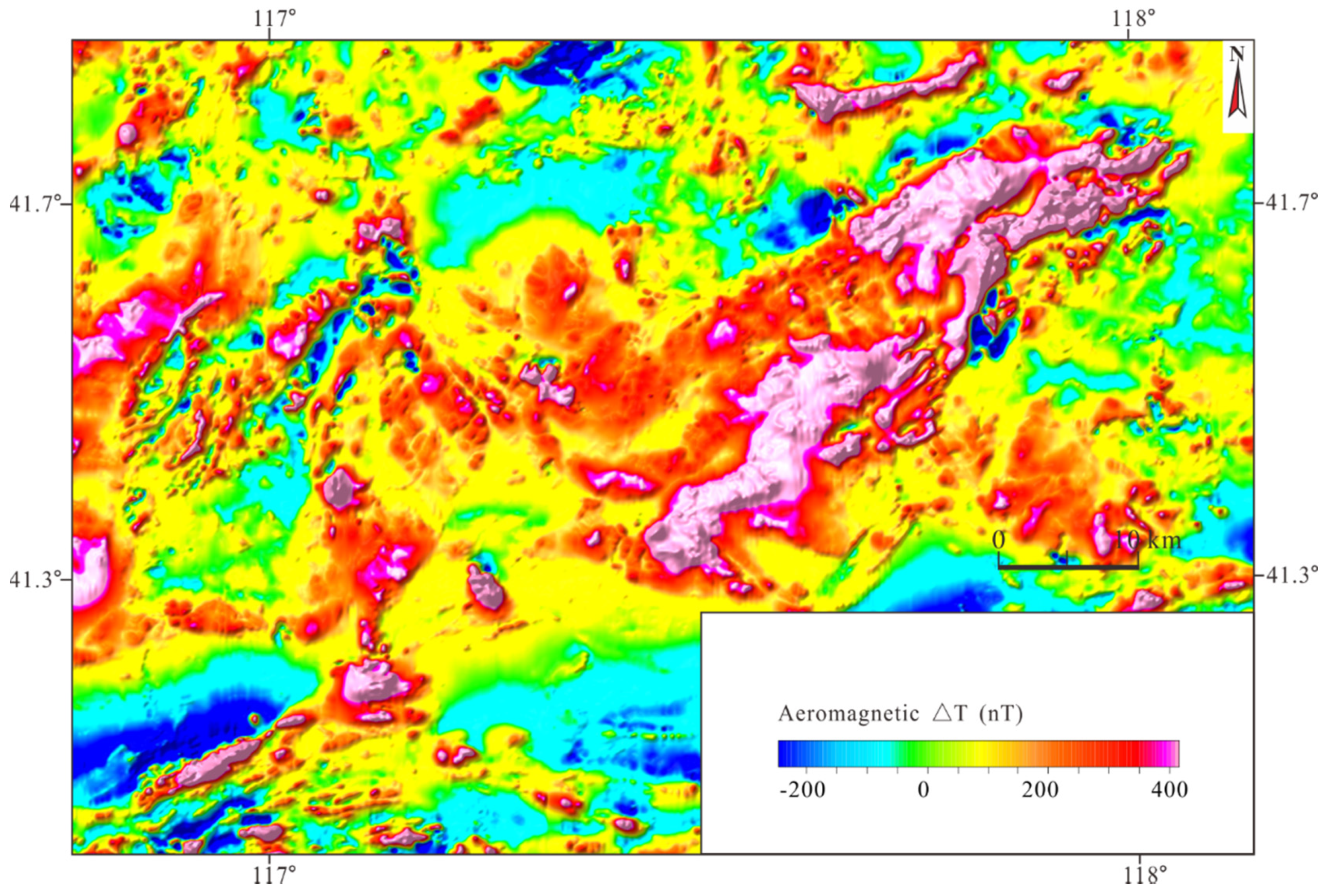
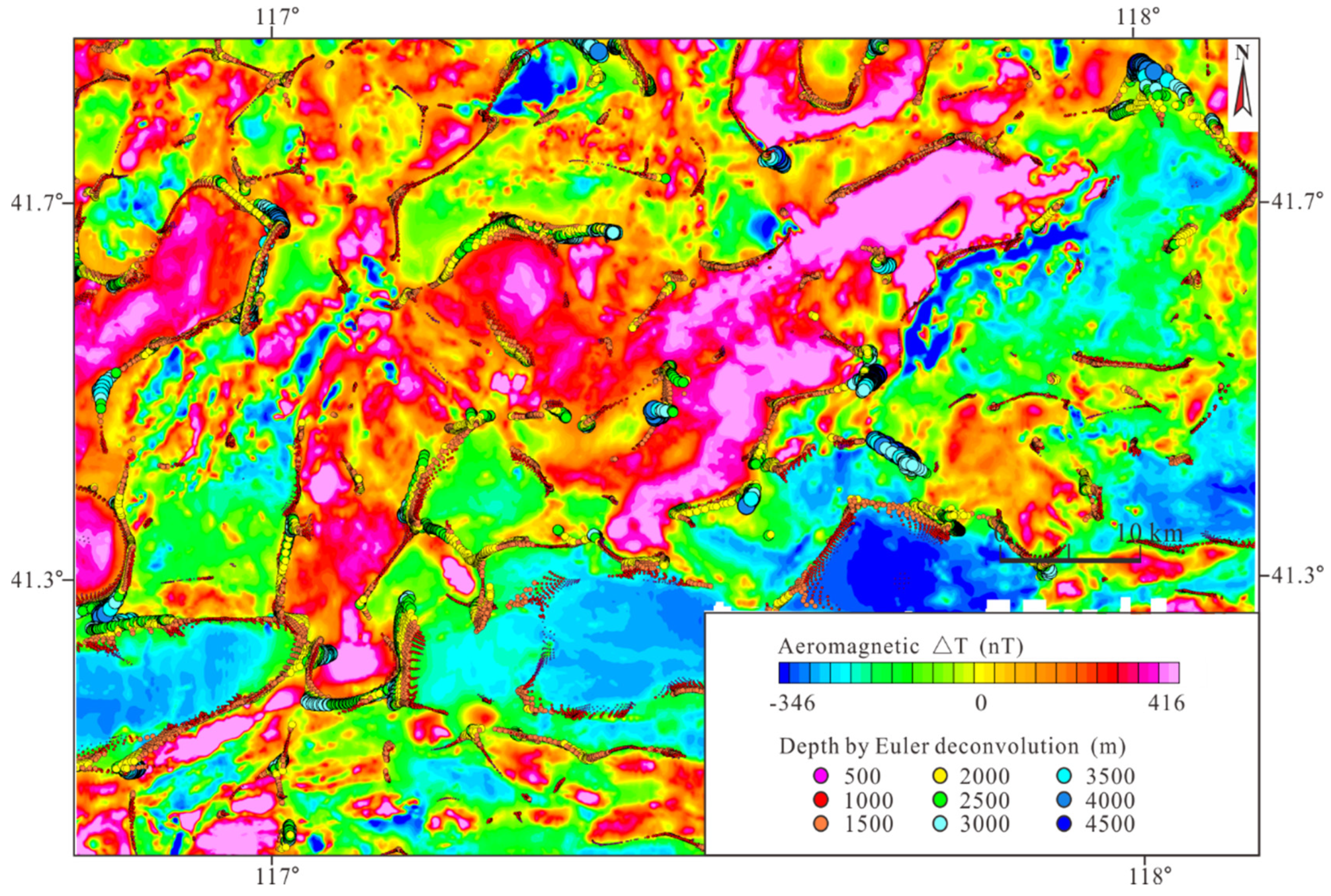
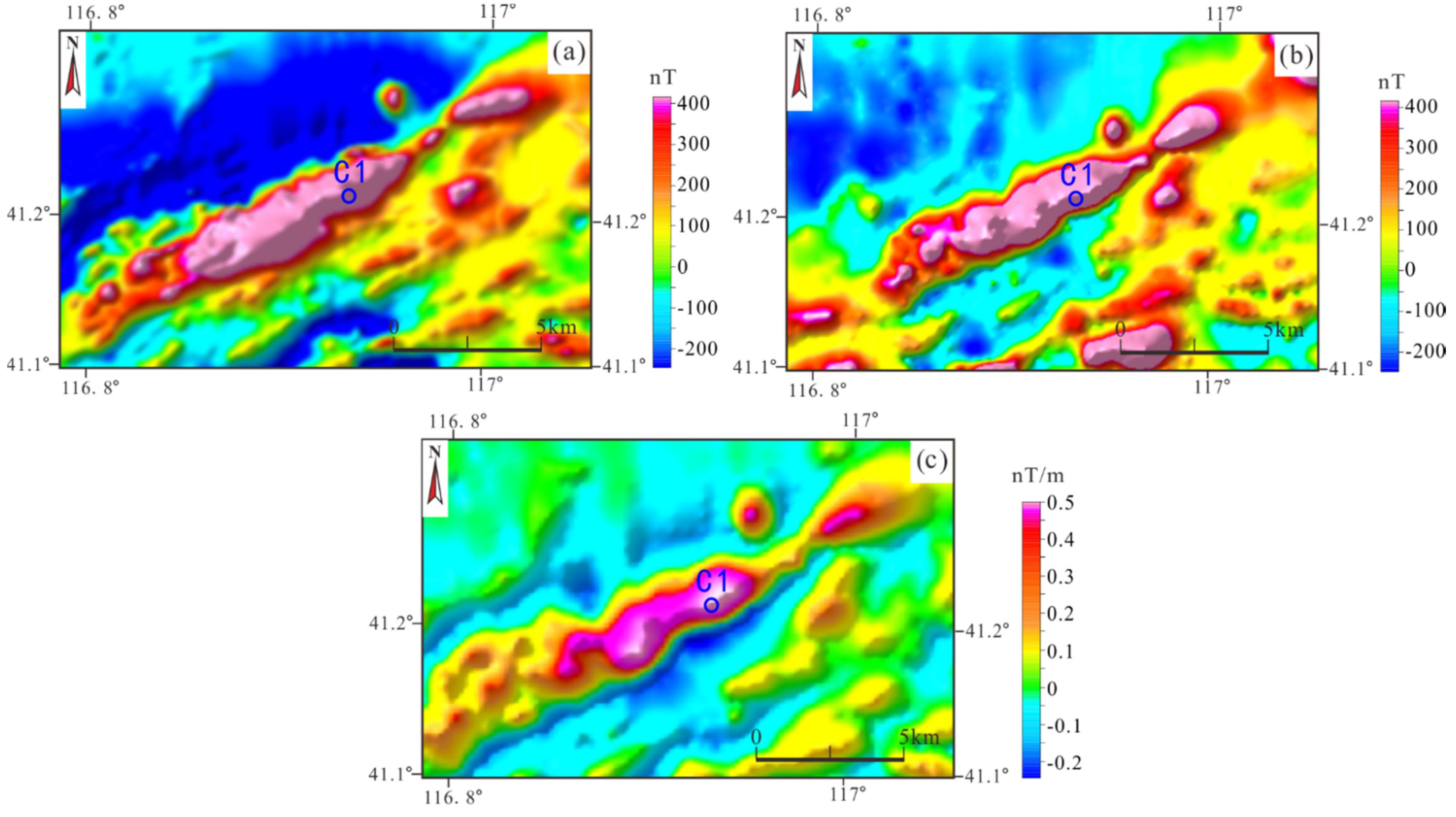
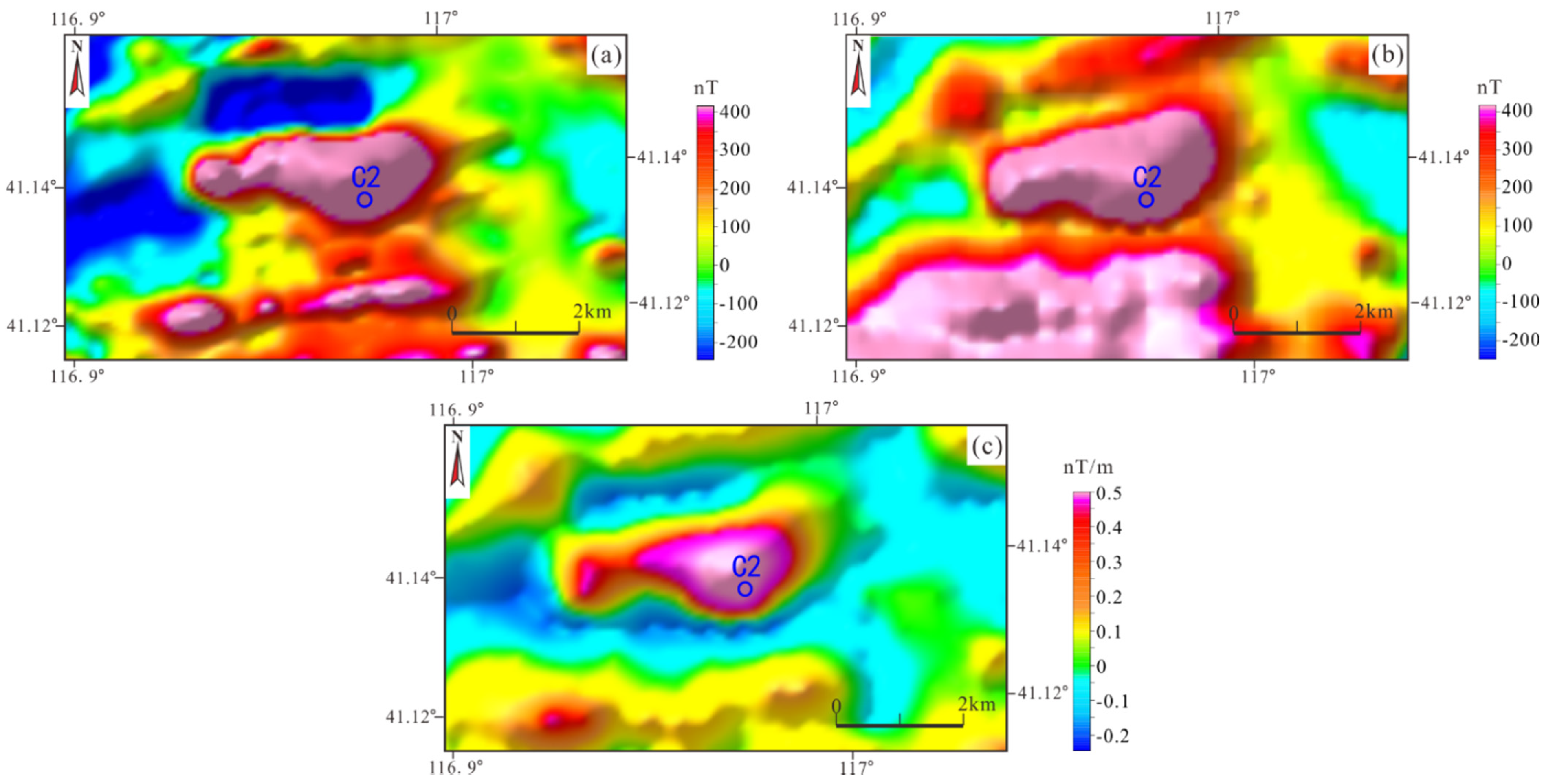
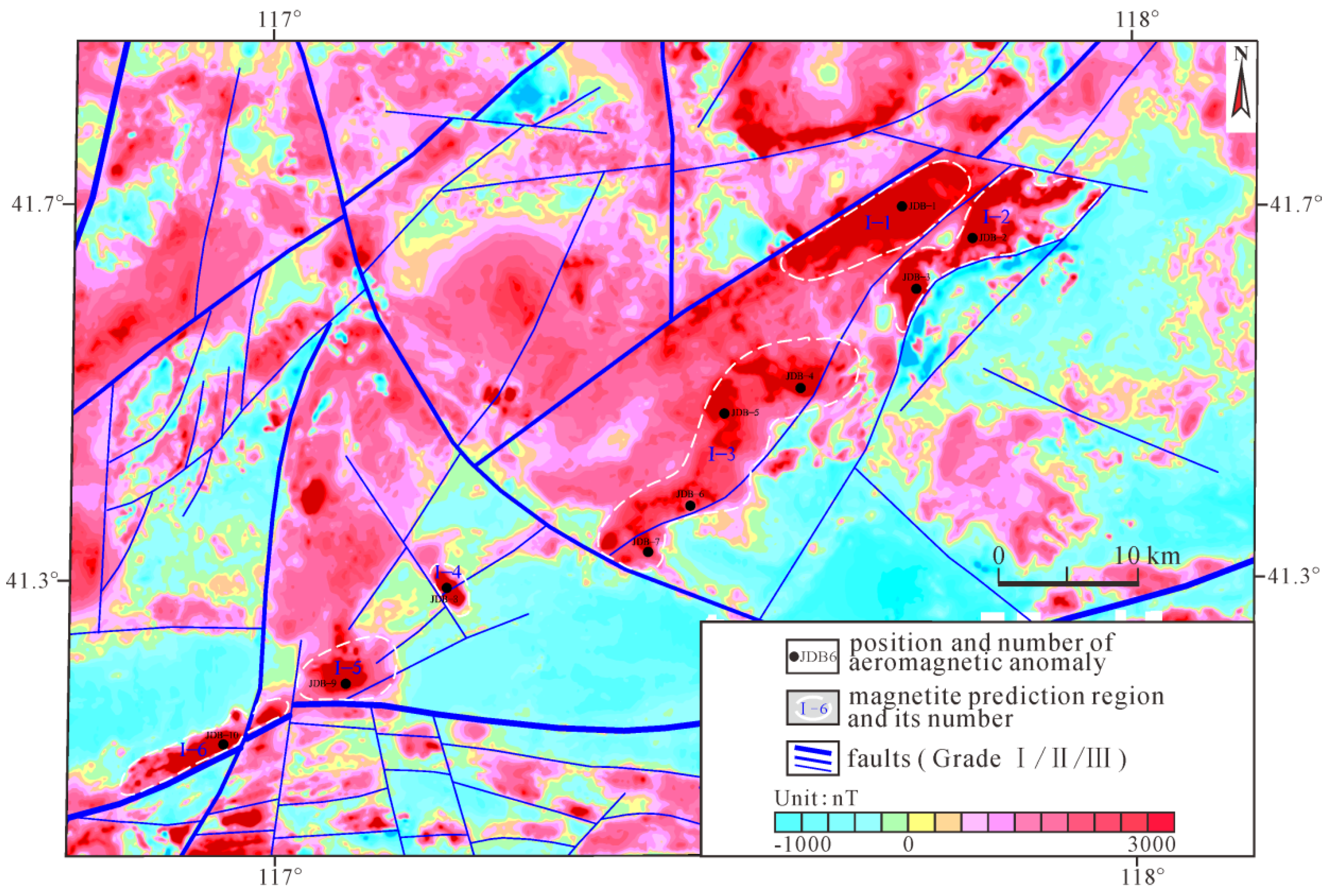
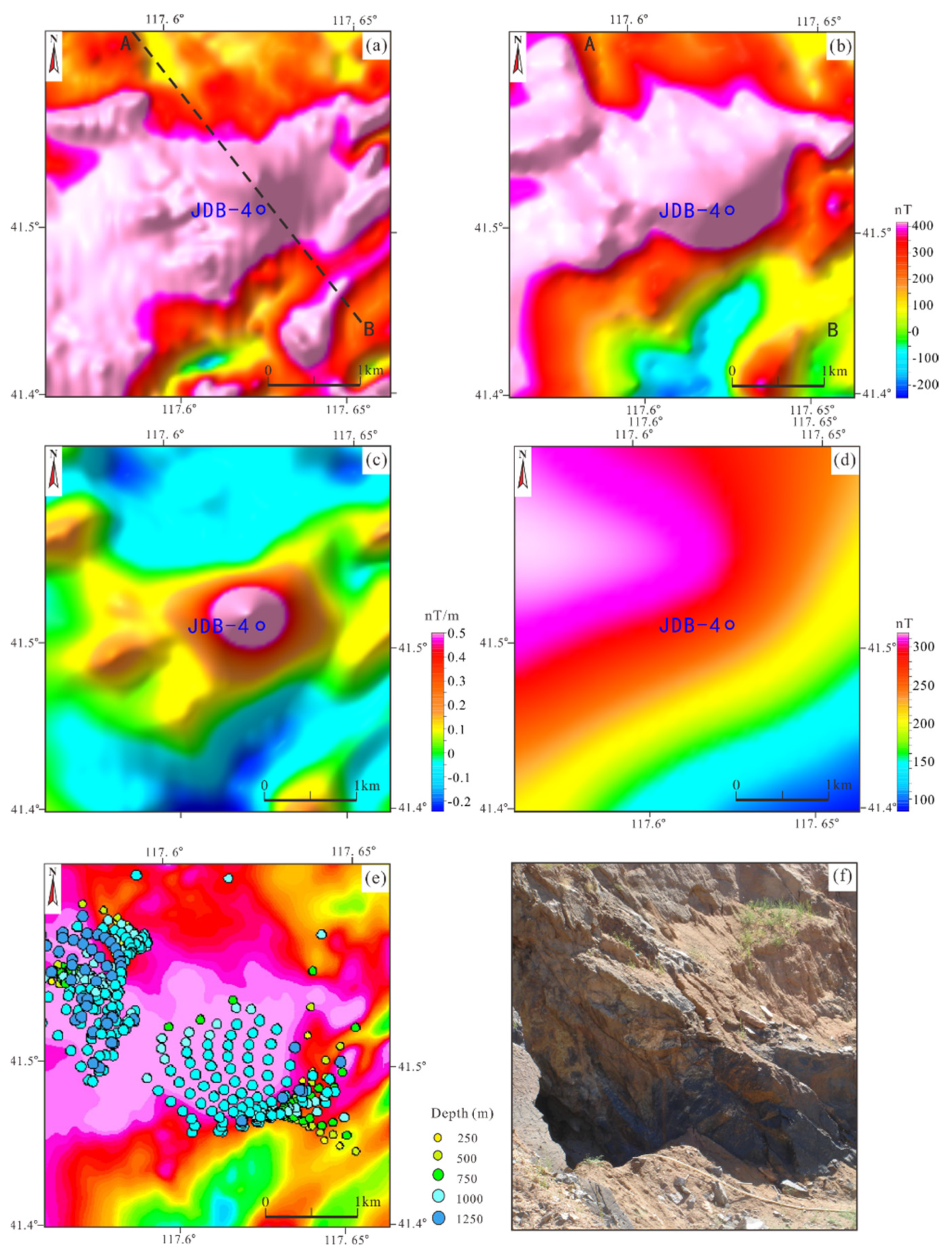

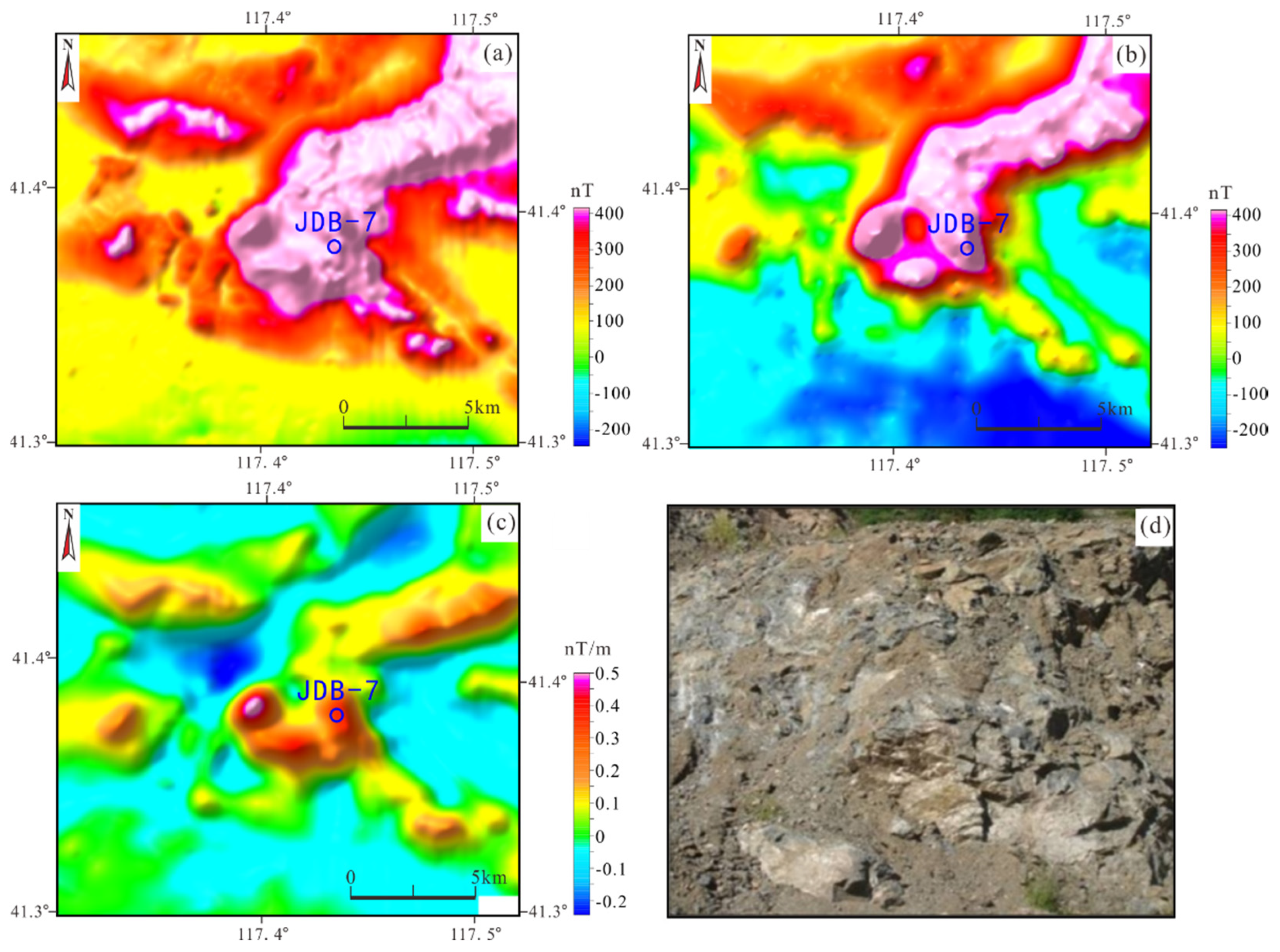
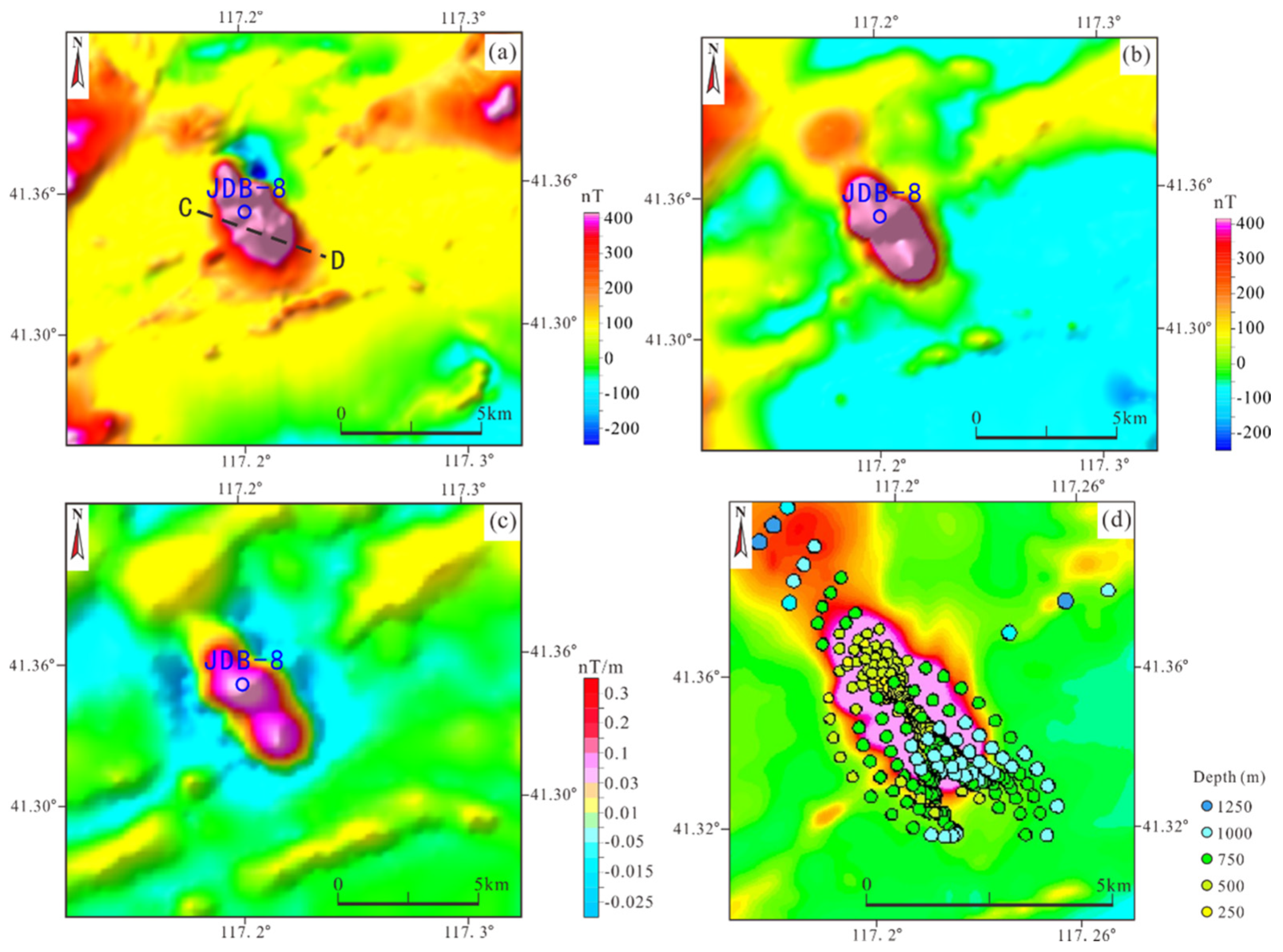

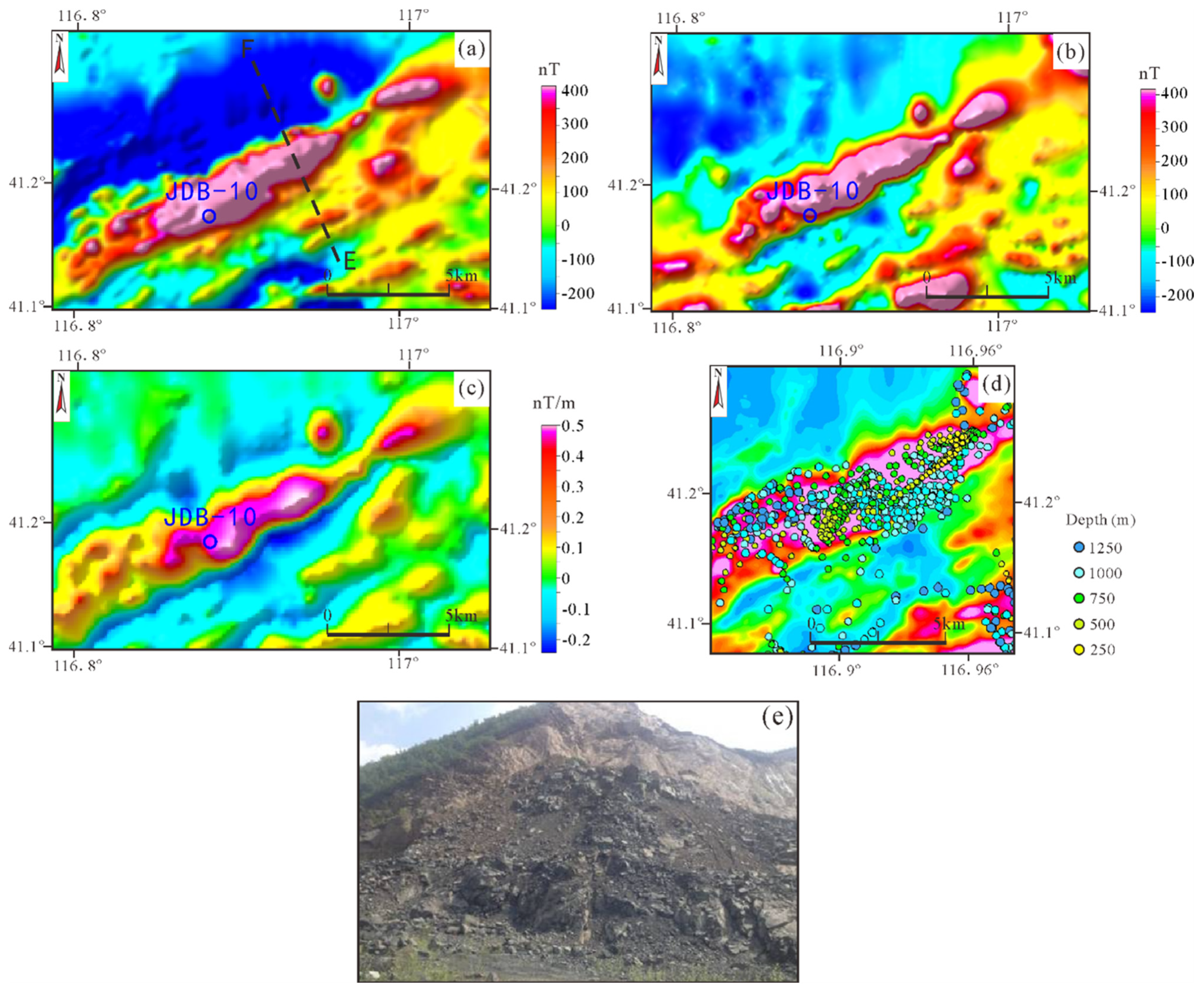
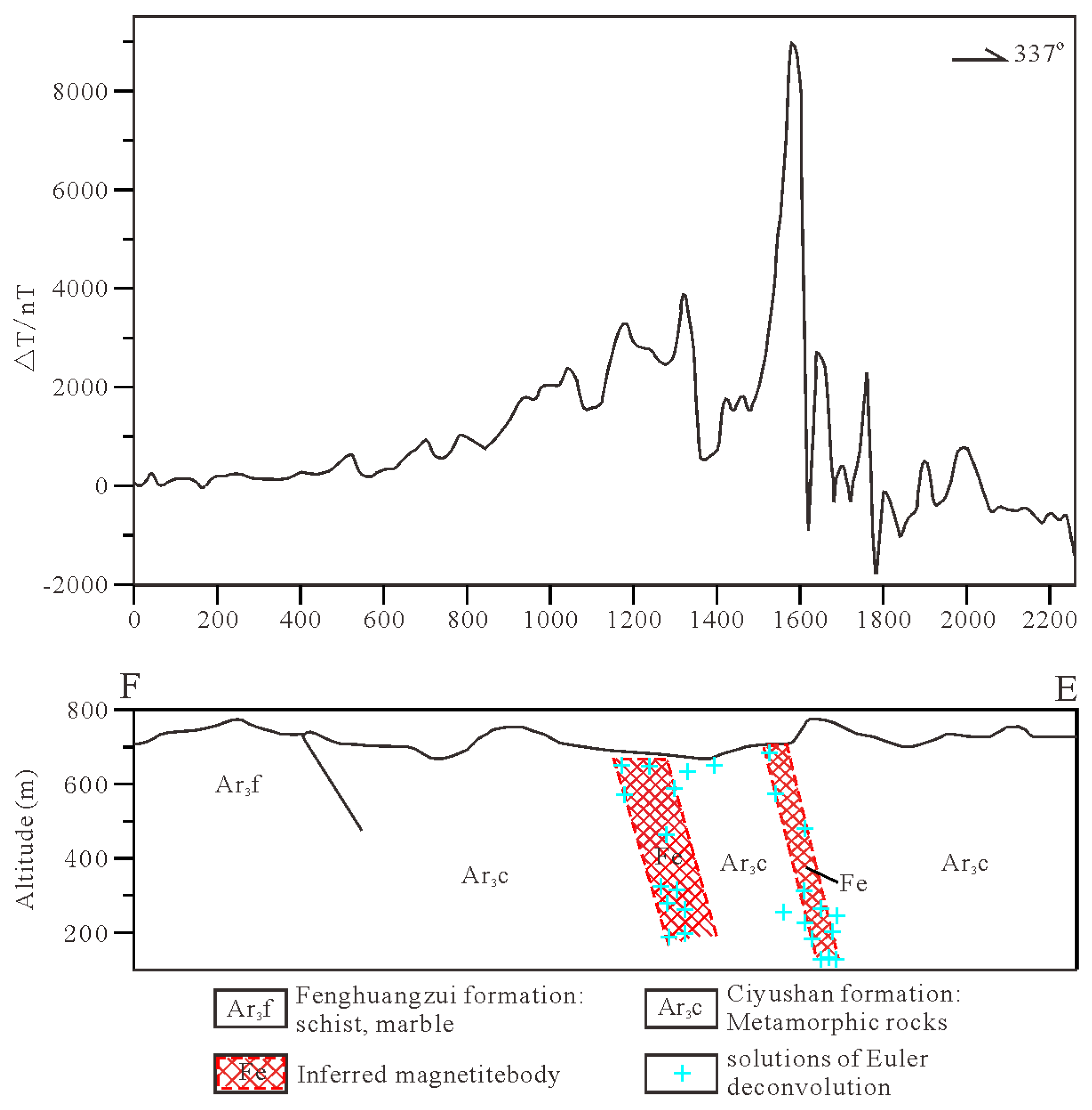
| Lithology Classification | Lithology | Measured Points | K (×10−5 SI) | ||
|---|---|---|---|---|---|
| Minimum Value −Maximum Value | Arithmetic Mean Value | ||||
| Sedimentary rock | Silty sand, Sandy soil, Glutenite, Sandstone, Mudstone | 1322 | 3–173 | 52 | |
| Limestone, Dolomite | 275 | 1–64 | 9 | ||
| Metamorphic rock | Amphibolite, Gneiss granulite, Meta granulite, Shallow granulite, Migmatite, Magnetite amphibole | 2522 | 3–18,315 | 1325 | |
| Quartz schist, Slate, Metamorphic sandstone | 751 | 3–405 | 62 | ||
| Marble, Quartzite | 452 | 0–143 | 11 | ||
| Volcanic rock | Acidic rock | Rhyolite, Rhyolitic tuff, Rhyolitic volcanic breccia | 1474 | 5–1294 | 263 |
| Intermediate rock | Trachyte | 270 | 23–3411 | 385 | |
| Trachyandesite | 602 | 3–2632 | 1109 | ||
| Andesite, Andesitic tuff, Andesitic volcanic lava | 1988 | 11–10,560 | 1183 | ||
| Basic rock | Basalt | 784 | 159–7504 | 1209 | |
| Intrusive rock | Acidic rock | Granite porphyry | 361 | 9–1315 | 227 |
| Granite | 1267 | 25–8463 | 862 | ||
| Intermediate-acid rock | Granodiorite porphyrite | 180 | 742–1956 | 962 | |
| Granodiorite | 330 | 20–3901 | 1026 | ||
| Basic rock | Syenite porphyry | 961 | 15–3602 | 302 | |
| Monzonite | 963 | 11–8297 | 534 | ||
| Syenite | 842 | 4–1578 | 591 | ||
| Diorite porphyrite | 120 | 941–4569 | 1429 | ||
| Diorite | 420 | 14–6155 | 1858 | ||
| Ultrabasic to basic rock | Diabase | 150 | 38–4986 | 1072 | |
| Gabbro | 120 | 441–5834 | 2117 | ||
| Pyroxenite | 150 | 1091–12,647 | 2472 | ||
| Mineral | Magnetite or magnetite quartzite | 933 | 912–210,000 | 41,293 | |
| Hematite | 120 | 42–327 | 102 | ||
| Polymetallic minerals (lead, zinc, and silver) | 120 | 6–19 | 13 | ||
| Auriferous quartz dyke | 90 | 16–98 | 47 | ||
| Copper molybdenum porphyry | 120 | 98–526 | 331 | ||
Publisher’s Note: MDPI stays neutral with regard to jurisdictional claims in published maps and institutional affiliations. |
© 2022 by the authors. Licensee MDPI, Basel, Switzerland. This article is an open access article distributed under the terms and conditions of the Creative Commons Attribution (CC BY) license (https://creativecommons.org/licenses/by/4.0/).
Share and Cite
Liu, Y.-X.; Li, W.-Y.; Liu, Z.-Y.; Zhao, J.-W.; Cao, A.-Q.; Gao, S.; Wang, L.-J.; Yang, C. Occurrence Characteristics of Magnetite and Aeromagnetic Prospecting Northeast of Hebei Province. Minerals 2022, 12, 1158. https://doi.org/10.3390/min12091158
Liu Y-X, Li W-Y, Liu Z-Y, Zhao J-W, Cao A-Q, Gao S, Wang L-J, Yang C. Occurrence Characteristics of Magnetite and Aeromagnetic Prospecting Northeast of Hebei Province. Minerals. 2022; 12(9):1158. https://doi.org/10.3390/min12091158
Chicago/Turabian StyleLiu, Yan-Xu, Wen-Yong Li, Zhi-Yuan Liu, Jia-Wei Zhao, An-Qi Cao, Shan Gao, Li-Jie Wang, and Cheng Yang. 2022. "Occurrence Characteristics of Magnetite and Aeromagnetic Prospecting Northeast of Hebei Province" Minerals 12, no. 9: 1158. https://doi.org/10.3390/min12091158
APA StyleLiu, Y.-X., Li, W.-Y., Liu, Z.-Y., Zhao, J.-W., Cao, A.-Q., Gao, S., Wang, L.-J., & Yang, C. (2022). Occurrence Characteristics of Magnetite and Aeromagnetic Prospecting Northeast of Hebei Province. Minerals, 12(9), 1158. https://doi.org/10.3390/min12091158





